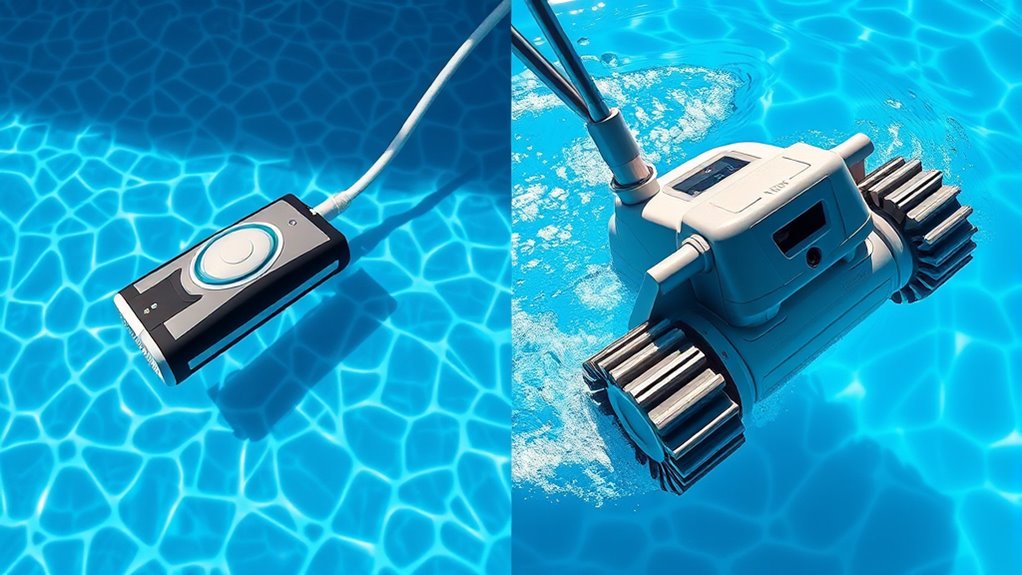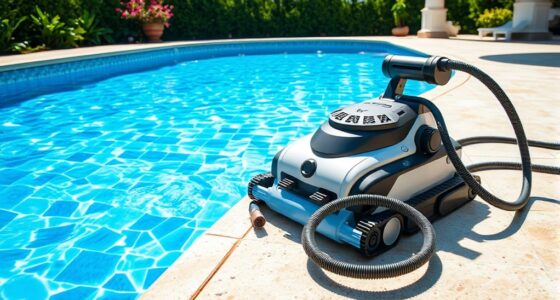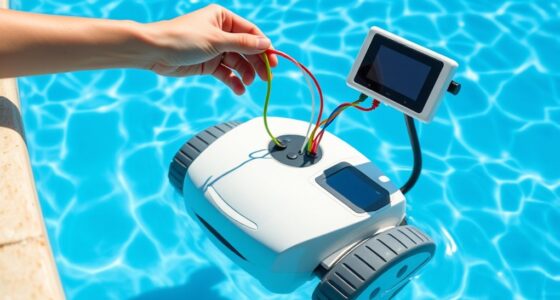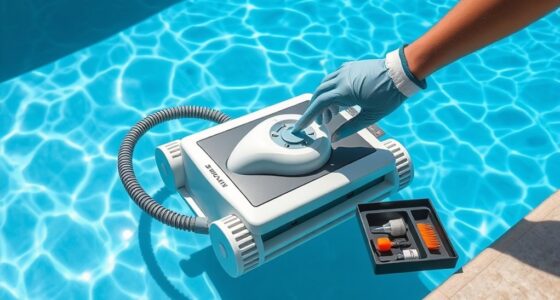Suction pool cleaners use your pool’s water flow to vacuum debris from surfaces, making them ideal for small to medium pools and lighter debris. Pressure cleaners rely on high-pressure jets to move around and tackle larger debris like leaves, perfect for big, open pools. Both systems have different setup, maintenance, and cost needs. To find out which one suits your pool and debris type best, explore the details below.
Key Takeaways
- Suction cleaners rely on pool’s vacuum system and are ideal for small to medium pools with light debris.
- Pressure cleaners use water pressure from a booster pump, suitable for large pools with heavy debris.
- Suction cleaners move actively on surfaces, while pressure cleaners follow a water jet-guided path with obstacle detection.
- Suction cleaners are generally cheaper and easier to install, whereas pressure cleaners are more durable but costlier.
- Suction cleaners excel at removing small debris, and pressure cleaners handle larger debris like leaves effectively.
How Suction Pool Cleaners Operate
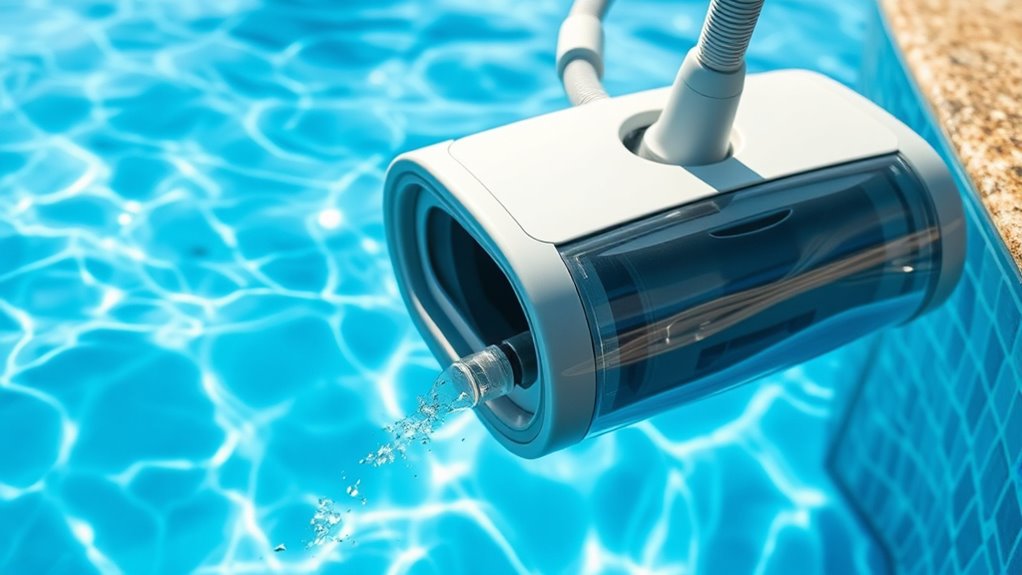
Suction pool cleaners work by creating a strong vacuum that pulls debris from the pool floor and walls. Your cleaner uses its suction power to generate a steady flow of water, which lifts dirt, leaves, and other debris into its filtration system. As it moves along the pool surface, it effectively picks up debris, guaranteeing thorough cleaning. The vacuum’s suction force is vital for debris collection, especially in areas with stubborn dirt or larger particles. Properly functioning suction ensures consistent debris removal, keeping your pool sparkling clean without much effort on your part. Additionally, the efficiency of suction pool cleaners depends on the proper connection to the pool’s skimmer or dedicated suction line, which supplies the necessary power for optimal operation. Regular maintenance of the vacuum’s suction components can help maintain optimal cleaning performance. Maintaining proper water flow is also crucial for maximizing the cleaner’s effectiveness and ensuring continuous operation. Furthermore, ensuring the filter system is clean and unobstructed helps sustain the necessary suction strength for effective cleaning. Regularly inspecting and cleaning these parts can prevent blockages that diminish cleaning efficiency, extending the lifespan of your pool cleaner.
How Pressure Pool Cleaners Function

Pressure pool cleaners use water pressure to move and scrub the pool surfaces effectively. They create a cleaning path by dispersing pressurized water, which propels the cleaner forward. This mechanism guarantees thorough coverage without needing a hose or skimmer attachment. Additionally, proper maintenance ensures the cleaner operates at peak efficiency and longevity. Regular inspections and cleaning of the pressure system help prevent clogs and ensure optimal performance. Moreover, understanding credit card security measures can help prevent unauthorized access and data breaches, which is crucial for maintaining trust and safety in digital transactions. Ethical hacking principles can be applied to ensure the cleaner operates securely and efficiently.
Water Pressure Mechanism
Water pressure plays a crucial role in how pressure pool cleaners operate, utilizing the flow of water to propel and direct cleaning mechanisms. When your pool’s pump circulates water through pool filter systems, it creates a steady pressure that powers the cleaner. This pressure drives internal turbines or jets, which generate movement and help the cleaner navigate the pool’s surfaces. As water circulates, it provides the force necessary for the cleaner to move along the pool floor and walls, dislodging dirt and debris. Unlike suction models, pressure cleaners rely on this consistent water flow to operate effectively. Proper water circulation ensures ideal pressure, allowing the cleaner to perform its job efficiently without manual intervention. Additionally, water flow dynamics play a vital role in optimizing the cleaner’s performance and coverage area. Maintaining optimal water pressure is essential for the pressure cleaner to work efficiently and cover the entire pool surface. Ensuring consistent water flow helps prevent blockages and maintains effective cleaning cycles. Furthermore, adequate water flow helps prolong the lifespan of the cleaner’s components by reducing undue strain during operation.
Cleaning Path Creation
As your pool’s pump maintains a steady flow of water, pressure pool cleaners use this flow to create a predictable cleaning path. Their navigation patterns rely on nozzles that propel the cleaner forward, allowing it to cover the pool surface systematically. Obstacle detection is key; these cleaners sense obstacles and change direction to avoid them, ensuring thorough cleaning. The cleaner’s movement depends on water jets and internal mechanisms that adjust its path automatically. Properly maintained pressure systems are essential for optimal operation and consistent cleaning performance. Regularly inspecting and cleaning the nozzles and filters ensures the cleaner functions effectively and prolongs its lifespan. Additionally, integrating automatic controls can further enhance cleaning efficiency and reduce manual intervention. To maximize performance, some models incorporate smart navigation technology that maps the pool for even more efficient coverage.
Performance and Cleaning Efficiency
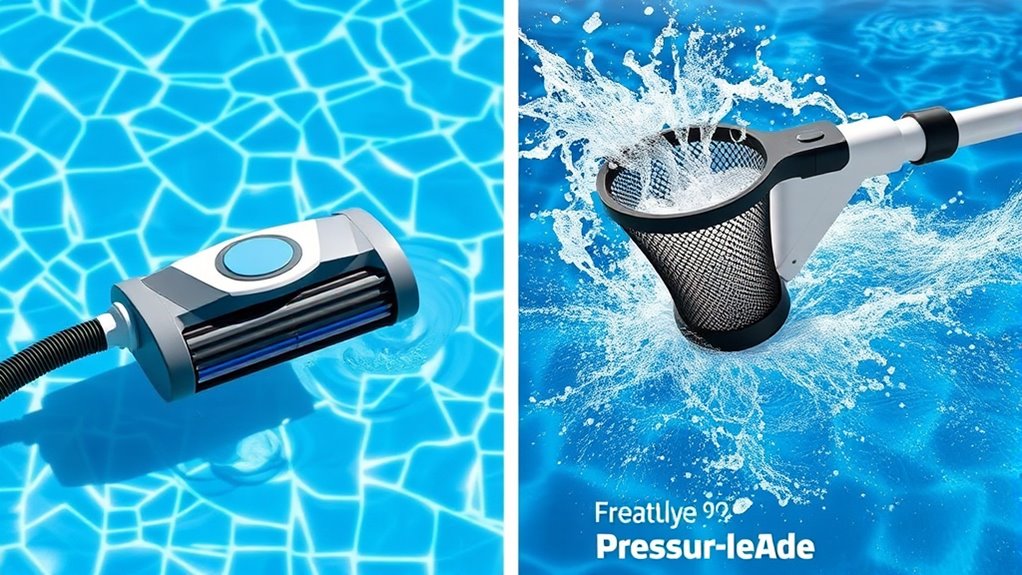
When it comes to cleaning performance, suction pool cleaners excel at removing debris by actively drawing dirt into their internal chambers, making them highly effective on surfaces with loose leaves and larger particles. They work best in smaller to medium-sized pools, where their debris capacity can handle regular cleaning without frequent emptying. These cleaners are particularly efficient at picking up larger debris, such as leaves and twigs, because of their strong suction power. Additionally, their simple mechanism often results in lower maintenance requirements compared to more complex pressure-based systems. Their straightforward design also makes them easier to troubleshoot and repair, which can be advantageous for pool owners seeking a hassle-free cleaning solution. Moreover, their reliable performance is supported by the fact that fewer moving parts reduce the chance of mechanical failure. The cost-effectiveness of suction cleaners can be appealing for budget-conscious pool owners. Furthermore, advances in tuning technology have led to improved suction efficiency and debris handling capabilities in newer models. However, their performance may decline in very large pools or when dealing with fine dirt and sand. Overall, if your pool isn’t overly big and you need reliable debris removal, suction cleaners deliver consistent cleaning efficiency, especially on surfaces with substantial loose debris.
Ease of Installation and Maintenance
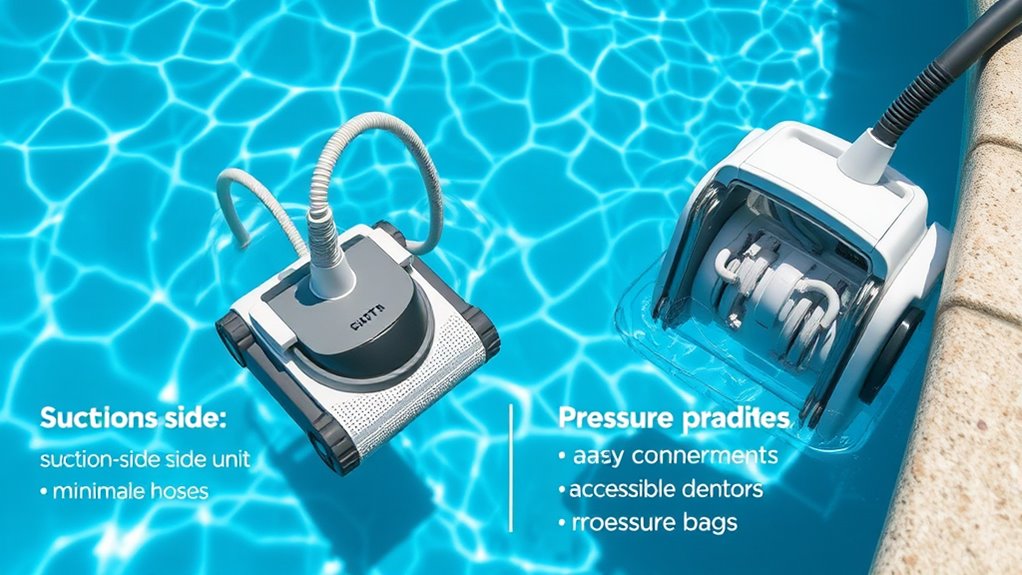
Installing your pool cleaner should be quick and straightforward, so you can start cleaning sooner. Both suction and pressure models typically require minimal setup, making them user-friendly. Maintenance is also simple, with few parts to check or replace regularly, keeping your pool care hassle-free. Additionally, choosing a model with digital literacy programs can help seniors better understand and manage their pool equipment easily. Regular inspections of the filter system ensure optimal performance and extend the lifespan of your cleaner.
Simple Setup Process
Suction and pressure pool cleaners are designed to be straightforward to set up and maintain, making them convenient choices for pool owners. You’ll find that installing these cleaners requires minimal effort, often just connecting hoses or attaching a skimmer connection. They handle your pool surface and debris collection efficiently without complicated steps. To help you understand the differences, here’s a quick comparison:
| Feature | Suction Cleaner | Pressure Cleaner |
|---|---|---|
| Setup | Simple hose connection | Attach to booster pump or pressure side |
| Maintenance | Easy, mainly cleaning filters | Regularly check hoses and parts |
| Pool surface compatibility | Works well on various surfaces | Suitable for larger debris |
| Debris collection | Effective with smaller debris | Better with larger debris |
| Ease of use | User-friendly, minimal setup | Slightly more involved setup |
Low Maintenance Requirements
Both suction and pressure pool cleaners are known for their low maintenance needs, making them popular choices for busy pool owners. They require minimal upkeep, mainly involving regular checks of the skimmer basket and filter cartridge. You’ll want to empty the skimmer basket frequently to prevent clogging and maintain ideal suction. The filter cartridge, easy to access, needs cleaning when it becomes dirty—usually every few weeks, depending on pool use. Unlike more complex systems, these cleaners don’t have many moving parts, reducing the risk of breakdowns. Their straightforward design means you spend less time on repairs or upkeep. Overall, both types offer hassle-free operation, allowing you to enjoy a clean pool without the burden of extensive maintenance.
Cost and Budget Considerations

When choosing between suction and pressure pool cleaners, your budget plays a crucial role in decision-making. Suction cleaners are generally more affordable upfront, making them a popular choice for budget-conscious pool owners. Pressure cleaners tend to be more expensive but often offer enhanced cleaning power and durability. It’s necessary to compare different pool cleaner brands to find options that fit your financial limits. Additionally, consider warranty coverage, as it can save you money on repairs down the line. Some brands offer longer warranties or extensive coverage, which adds value to your purchase. Keep in mind that while initial costs are important, investing in a reliable cleaner can reduce maintenance and replacement expenses over time, helping you stay within your budget while maintaining a clean pool.
Ideal Pool Types and Usage Scenarios
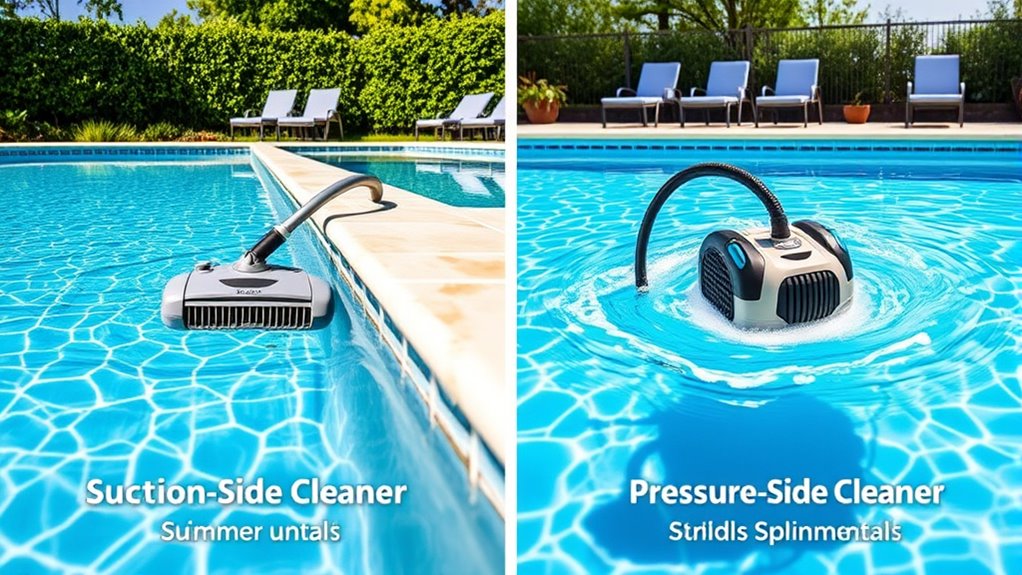
Choosing the right pool cleaner depends largely on your pool’s size, shape, and usage patterns. For smaller pools with simple debris, a suction cleaner is ideal, as it handles light debris efficiently and is easy to maintain. If your pool is large or has complex debris like leaves, a pressure cleaner works better because it covers more ground quickly and handles heavier debris more effectively. For pools with tight corners or intricate shapes, a suction cleaner’s precise navigation can be advantageous. Conversely, pressure cleaners excel in larger spaces with open layouts, where their power and coverage speed up cleaning. Understanding your pool’s size and debris complexity helps you pick a cleaner that fits your needs, ensuring efficient cleaning and longer equipment lifespan.
Frequently Asked Questions
Which Cleaner Is More Environmentally Friendly?
When choosing a pool cleaner, you might wonder which is more eco-friendly. Generally, suction cleaners tend to have eco-friendly features like energy efficiency and use less power. Look for models made with biodegradable materials, which reduce environmental impact. By selecting a cleaner with these features, you help protect the environment while maintaining your pool. Always check product details for eco-friendly certifications or sustainable materials to make the best choice.
Can Suction and Pressure Cleaners Be Used Together?
Think of your pool cleaning system like a multi-tool; you can use dual function options or hybrid cleaning systems to tackle different tasks. Yes, you can use suction and pressure cleaners together, especially with systems designed for it. These hybrid cleaning systems optimize cleaning efficiency by combining the strengths of both. Just confirm your pool’s plumbing supports this setup, and you’ll enjoy a cleaner pool with less effort.
How Do Weather Conditions Affect Cleaner Performance?
Weather conditions markedly impact your pool cleaner’s performance. Heavy rain or storms can wash debris into your pool, making cleaning more challenging and sometimes overwhelming the cleaner’s capacity. Hot, dry weather may cause algae growth, requiring more frequent cleaning. Cold temperatures can affect the cleaner’s parts, especially if it’s not designed for winter use. Climate considerations help you choose the right cleaner and maintain ideal performance year-round.
Are There Safety Concerns With Either Type?
They say safety first, and that’s true for any pool cleaner. Both suction and pressure models have safety hazards, like moving parts or electrical risks if not maintained properly. Regular maintenance minimizes these risks, but always follow manufacturer instructions. Be cautious during installation and cleaning, and keep an eye on potential issues. With proper care, you can enjoy a safe, clean pool without worry.
Which Cleaner Has Better Battery Life or Power Source Longevity?
You’re probably wondering which cleaner offers better battery efficiency and power durability. Generally, pressure pool cleaners rely on your pool’s pump, so they don’t depend on batteries and have consistent power, but they’re less portable. Suction cleaners often use rechargeable batteries, so their battery efficiency can vary. If you want longer-lasting power without frequent recharges, pressure cleaners tend to have better power durability, while battery-powered suction cleaners may need more frequent charging sessions.
Conclusion
Choosing between suction and pressure pool cleaners is like picking the perfect tool for a masterpiece—you want flawless results. Both options have their strengths, but understanding their differences helps you make the best decision for your pool. Whether you want lightning-fast cleaning or easy maintenance, your ideal cleaner is out there. With the right choice, you’ll have a sparkling pool that looks like a resort—no magic required!
